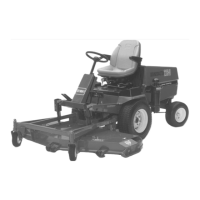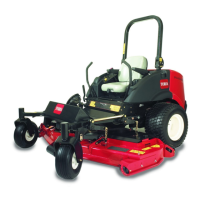The purpose of the safety interlock system is to prevent
the engine from cranking or starting unless the traction
pedal is in neutral and the PTO switch is in the OFF
position. In addition, the engine will stop when the PTO
control is engaged or traction pedal is depressed with
operator off the seat.
* )*/ %.*))!/ /$! ."!/4 .2%/$!. !5
0.! /$!4 -! "*- /$! *+!-/*-. +-*/!/%*)
$!& *+!-/%*) *" /$! .2%/$!. %'4 /* !
.0-! /$! %)/!-'*& .4./!( %. *+!-/%)# *--!/5
'4 " .2%/$ %. ('"0)/%*)%)# -!+'! %/ !5
"*-! *+!-/%)# /$! ($%)! !+'! /$!
.2%/$!. !1!-4 4!-. /* ! .0-! *" (3%(0(
."!/4
Move PTO switch to OFF position and remove foot
from traction pedal so it is fully released.
Rotate the ignition key to START. Engine should
crank. If engine cranks, proceed to step 3. If engine
does not crank, there may be a malfunction in the
interlock system.
Raise off the seat and engage the PTO switch while
the engine is running. The engine should stop within 2
seconds. If engine stops, the switch is operating
correctly; thus, proceed to step 4. If engine does not
stop, there is a malfunction in the interlock system.
Raise off the seat and depress the traction pedal
while engine is running the PTO lever is disengaged.
The engine should stop within 2 seconds. If engine
stops, the switch is operating correctly; thus, continue
operation. If engine does not stop, there is a
malfunction in the interlock system.
Practice driving the GROUNDSMASTER 223-D
before initial operation because it has a hydrostatic
transmission and its characteristics are different than
some turf maintenance machines. Some points to
consider when operating the traction unit and cutting
unit are the transmission, engine speed, load on the
cutting blades, and the importance of the brakes.
To maintain enough power for the traction unit and
cutting unit while mowing, regulate traction pedal to
keep engine rpm high and somewhat constant. A good
rule to follow is: decrease ground speed as the load on
the cutting blades increases; and increase ground
speed as load on the blades decreases. This allows the
engine, working with the transmission, to sense the
proper ground speed while maintaining high blade tip
speed necessary for good qualityĆofĆcut. Therefore,
allow traction pedal to move upward as engine speed
decreases, and depress pedal slowly as speed
increases. By comparison, when driving from one work
area to anotherĊwith no load and cutting unit
raisedĊhave throttle in FAST position and depress
traction pedal slowly but fully to attain maximum
ground speed.
!,0/! -!- 2!%#$/ %. )!!..-4 /* +-!1!)/
/$! -!- 2$!!'. "-*( '!1%)# /$! #-*0) *
)*/ ./*+ .0 !)'4 2$%'! 0//%)# 0)%/ *- %(+'!5
(!)/ %. -%.! * )*/ /-1!' *2) $%'' 2%/$ /$!
0//%)# 0)%/ *- %(+'!(!)/ -%.! " /$! -!-
2$!!'. '!1! /$! #-*0) ./!!-%)# %. '*./
This product may exceed noise levels of 85
dB(A) at the operator position. Ear protectors are
recommended for prolonged exposure to reduce the
potential of permanent hearing damage.
Another characteristic to consider is the operation of
the brakes. The brakes can be used to assist in turning
the machine; however, use them carefully, especially
on soft or wet grass because the turf may be torn
accidentally. The brakes can be used to great
advantage to control the direction of the cutting unit
when trimming along fences or similar objects. The
other benefit of the brakes is to maintain traction. For
example; in some slope conditions, the uphill wheel
slips and loses traction. If this situation occurs, depress
uphill brake pedal gradually and intermittently until the
uphill wheel stops slipping; thus, increasing traction on
the downhill wheel. If independent braking is not
desired, engage the lever on left brake pedal with right
pedal. This provides simultaneous braking at both
wheels.
Before stopping the engine, disengage all control and
move throttle to SLOW. Moving throttle to SLOW
reduces high engine speed, noise and vibration. Turn
ignition key to OFF to stop the engine.

